Chase Woods Nature Preserve
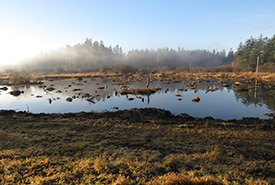
Morning mist over Chase Woods (Photo by Ren Ferguson)
Harbouring an intact example of the old-growth coastal Douglas-fir forests that once dominated southeastern Vancouver Island, Chase Woods is an important remnant of an ecosystem that has been significantly impacted by expanding development in southwestern British Columbia.
Chase Woods represents an ecologically and culturally significant piece of the Cowichan Valley mosaic. Rising from sea level to almost 400 metres at the summit of Mt. Tzouhalem, Chase Woods nurtures a microcosm of the rare Coastal Douglas-fir ecosystem in all its diversity.
This 40-hectare nature preserve is located on Mt. Tzouhalem in the Cowichan Valley and includes dramatic cliffs that offer spectacular panoramic views of Cowichan Bay and the valley beyond. This land is in the heart of the traditional territory of the Cowichan Tribes, and Chase Woods itself holds significant cultural value to the Cowichan Peoples, who continue to use the site to this day.
Connected to the Mount Tzuhalem Ecological Reserve via the forested slopes of Providence Farm, Chase Woods supports a natural treasure that is already well-loved by naturalists, hikers, historians and countless others from the local community and beyond.
Nature Destination
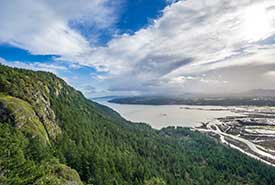
View from Chase Woods (Photo by Chris Istace)
Chase Woods Nature Preserve was designated a Nature Destination in 2019. Visitors access the preserve via a popular network of trails that criss-cross Mt. Tzouhalem, passing through municipal forest land, provincial Mount Tzuhalem Ecological Reserve, Providence Farm and Chase Woods. The challenging trek rewards hikers with a panoramic view of Cowichan Valley.
Hikers and mountain bikers alike use these trails, so please use caution and be aware of your surroundings when visiting these trails. Visitors to NCC's conservation lands do so at their own risk. Hike and explore safely.
Ecological significance
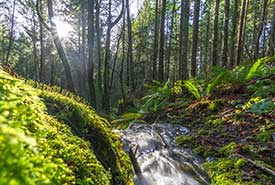
Forest and stream on Chase Woods (Photo by Chris Istace)
Older Coastal Douglas-fir ecosystems are among the rarest landscapes in British Columbia and are considered of the highest conservation value. Chase Woods supports 33 hectares of thriving Coastal Douglas-fir habitat, nurturing centuries-old western yew, Douglas-fir, Garry oak, lodgepole pine and arbutus. The preserve is home to a number of rare species and habitat types, including the globally imperiled Garry oak plant community. Dramatic boulder fields, hidden caves and steep cliffs create structural diversity and support a multitude of small mammals, bats and birds of prey. Streamside habitat on the preserve supports numerous amphibian species.
Chase Woods connects to the Cowichan Bay estuary, much of which is already protected by other conservation organizations. The adjacent undeveloped slopes of Providence Farm allow rare species to move between the Mount Tzuhalem Ecological Reserve and Chase Woods. Nearby, the Cowichan Garry Oak Preserve harbours many valuable and rare species that will benefit from increased habitat in the general area.
Wetland restoration project
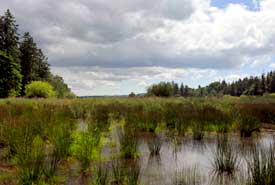
Wetlands on Chase Woods Nature Reserve (Photo by NCC)
The low-lying areas of Chase Woods were once intertidal marsh lands that connected to the Cowichan estuary at high tide and providing important habitat for salmon and migratory waterfowl. The wetland areas also attract large breeding congregations of Pacific tree frogs, great blue herons and raccoons. In the early 20th century, this land was drained and converted for agriculture, and though remnants of wetlands remain, most was lost. Since 2018, the Nature Conservancy of Canada (NCC) has been working on an ambitious restoration project to restore close to 2.5 hectares of these wetlands.
The project focuses on recreating the historical slow and winding path of a creek that had long ago been diverted into a deep ditch to drain the marshland. This was accomplished by creating six wetland ponds and allowing them to naturally refill. Native vegetation was planted in and around the wetland pools. The removal of invasive plants, especially reed canary grass, is an ongoing challenge.
Taking the pulse of the wetland
Since 2018, local avian survey specialist Ren Ferguson has been monitoring the wetland. Through observations and audio recordings, Ferguson has determined that there are higher numbers and more types of birds using this area today than there were before the restoration project began. And not just birds — frogs, fish and a whole variety of insects are showing up to take advantage of the wetland habitat.
Her studied showed that in only three years after the restoration began, at least 10 new bird species had started using the new wetlands. The newcomers included northern flicker, Virginia rail and Cooper’s hawk. Waterfowl had once again began overwintering at the site, and the appearance of diving ducks indicated that the wetland is developing diverse food sources.
Part of Ferguson’s research approach involves highly sensitive sound recordings, which are useful in determining what wildlife are present in a nature area, as well as how dense their populations are. Audio recordings are proving very useful in revealing changes over time within a given landscape. They can provide important information to help land managers adapt stewardship practices to best support biodiversity. They also offer a unique way to share the importance of a conservation area to people who might not be able to visit it first-hand.
Ferguson has also made recordings at the nearby Cowichan Garry Oak Preserve and at the Sage and Sparrow Conservation Area in the South Okanagan.
Chasing conservation
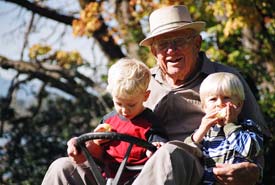
David Chase and his grandsons, Chase and Woods. (Photo courtesy of the family)
David and Louise Chase came to the Cowichan Valley in the 1950s intending to log a property they had purchased sight unseen. But upon setting foot in the grand Douglas-fir forest, their priorities changed. The Chases settled on the property and spent five decades carefully tending their beloved forest and sharing their private park with friends. After Louise passed away, David cared for the property until, at age 98, he began looking for a new land steward.
“I spent half my working life keeping it like a park,” he said at the time. “But I'm out of gas, so it's time for someone else to take care of it now.”
NCC acquired Chase Woods in 2009, fulfilling David's dream of protecting the towering trees forever.





